The Paxman-Ricardo RQ Engine Range
Basic information about the Paxman-Ricardo RQ engine range can be found in the RQ section of the page Paxman Diesel Engines since 1934.
History
In 1932 the Agricultural & General Engineers combine collapsed into bankruptcy, taking Paxman with it. After arranging some refinancing, the Paxman business was re-formed that year with Edward Paxman, the founder's son, being appointed as Technical Director. The same year the company began a long-standing association with Harry (later Sir Harry) Ricardo. The first-fruit of this collaboration was the Paxman-Ricardo RQ engine.
The RQ was an indirect injection engine, fitted with cylinder heads incorporating Ricardo Comet combustion chambers. The RQ was basically a Ricardo design, put into production by Paxman.
The Paxman-Ricardo RQ, developing 11 bhp per cylinder at 1000 rpm, was first offered to the market in 1934. Before its introduction Paxman's fastest engine ran at 750 rpm. RQs ran at between 1000 and 1500 rpm, making them the Company's first high speed diesels - or, more accurately, what was considered as high-speed for diesels at that time.
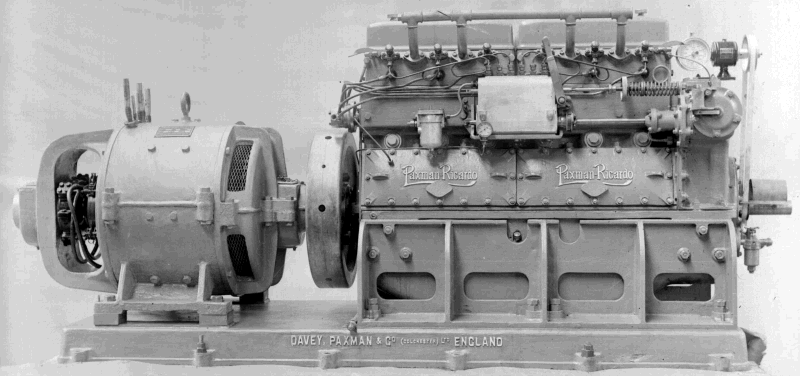
6-cylinder RQ direct coupled to a 40kW Campbell & Isherwood Generator for Marine Auxiliary.
Photo © Paxman Archive Trust
The RQ engine range was built from 1934 to 1953. After 1948 only 4-cylinder types were built.
Basic Specifications of the RQ:
- Bore and Stroke: 4.5/8" x 5.7/8"
- Cylinder configurations: 1, 2, 3, 4, 5, 6 - all in-line. (Only 4-cylinder after 1948)
- Power output: 11 bhp per cylinder at 1,000 rpm, 15 bhp per cylinder at 1,500 rpm.
- Other features: Compression ratio 18 : 1. Ricardo Comet Mk III combustion chamber. Naturally aspirated.
RQ Engine Production
The numbers of RQ engines built, and of those built for rail traction applications, are as follows:
1RQ 101 built, of which 1 was for Rail Traction
2RQ 179 built, of which 29 were for Rail Traction
3RQ 116 built, of which 3 were for Rail Traction
4RQ 3112 built, of which 21 were for Rail Traction
4RQE 1 built. This appears to have been despatched in 1949 for an exhibition at Olympia.
The build was listed as 'Industrial'. As was common for 'show' engines such as this, it may have had some dummy parts fitted and thus not have been exhibited in running order. Nothing further seems to have become of the 4RQE.
5RQ 31 built, of which 3 were for Rail Traction
6RQ 92 built, of which 22 were for Rail Traction.
6RQE 26 built. All were sold to The North British Locomotive Company. See notes below.
RQ Engine Applications
Other pages on this site that include information about applications of the RQ can be viewed using the following links : -
Marine - Non-Naval (Most RQs were auxiliaries for onboard power generation)
Marine - Naval (All RQs were auxiliaries for onboard power generation)
Large numbers of 4RQ generator sets were supplied to the Ministry of Supply early in World War 2. Orders included, for example, a batch of 300, Serial Nos. 1702 to 2001, and a batch of 500, Serial Nos 2236 to 2735.
An account of Paxman's World War II Production, written in 1945, records ten main wartime applications of the RQ as follows:-
- Coupled to 30 kW generators for Tribal, 0 & P, A & B Class Destroyers, as well as for Destroyers built in Australia, and in China River Gunboats.
- Coupled to 25 kW generators for minelayers and minesweepers.
- Coupled to 36 kW generators for "Degaussing" sets, the earliest and most potent defence against the original magnetic mine.
- As an Army unit, built into 30 kVA self-contained semi-portable generating sets, complete with switch boards for A.A. guns. Hundreds of these sets had to be running from the time the first flying bomb appeared until the menace ceased and many of them had to run for very long periods on end.
- Coupled to 30 kW generators for major landing craft, L.C.Ts, L.C.G.(M), L.C.T.(8), etc. These all needed dependable auxiliary power. The general familiarity of army and navy with Davey Paxman engines enabled some remarkable damage control to be effected by army personnel when naval personnel had been wounded.
- Coupled to 22 kW generators for A.A. guns and kindred services for the Burma campaign.
- As power units for portable milling plants for Continental rehabilitation purposes.
- Coupled to cargo petroleum pumps for tankers for use as transfer units.
- Coupled to 24 kW Alternators as portable sets for communications.
- Coupled to 25 kW generators for the Ministry of War Transport, for shipboard use.
The 6RQE was a 6-cylinder, fully flame-proofed and low-emissions version of the RQ, specially designed for underground use. Its power rating was 100 bhp at 1,250 rpm. Paxman supplied 26 of these engines to the North British Locomotive Company (NBL) for powering its small compact 0-4-0 'Miner' locomotives.
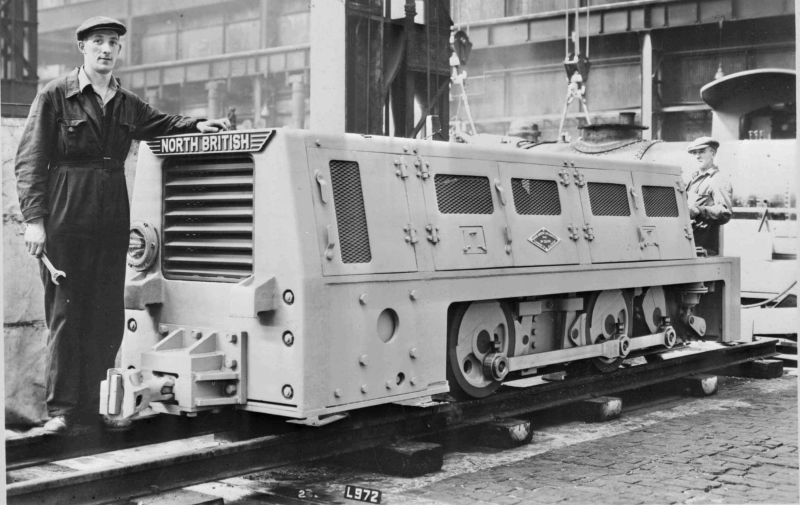
The North British Locomotive Company's 'Miner' for use in mines.
Photo © Paxman Archive Trust
The first 6RQE was despatched prior to 1st August 1948 and was possibly the engine NBL installed in its prototype 'Miner' locomotive. A further thirteen 6RQEs were despatched to NBL in late 1948 and 1949 for use in its Miner locomotives. Another two were supplied in 1950, and one in 1952. Finally, in 1953 another nine were sent to NBL. Eight of these were listed as 'Industrial' and were 'standard build' industrial engines that Paxman happened to hold in stock. It is thought these engines would have been converted to Rail Traction build at NBL's works.
The NBL sold several of its 'Miner' locomotives to the National Coal Board (NCB) for use in its collieries in the Northeast of England. Others were sold for duty in the Northern Rhodesia (now Zambia) Copperbelt. Four went to the Rhokana Copper Mine (3 ft gauge) for underground duties, the first two arriving in 1948 and the second two in 1954/5. One went to the Nkana Copper Refinery where it was employed as a surface shunter. There is reference to this locomotive in the August 1954 issue of Diesel Railway Traction (p.195). Powered by a non-flameproofed 6RQE, it seems likely this was North British Order No L40, Works No 27416, a 3 ft 6 in gauge locomotive built in 1954. Its engine was probably the 6RQE shown in Paxman records as being supplied to the North British Locomotive Co in mid-1953 for a shunting locomotive for "Rhodesian Copper Refineries". Paxman records specifically mention that this engine was for a surface-based shunting locomotive, not an underground one, and that it was not flameproofed.
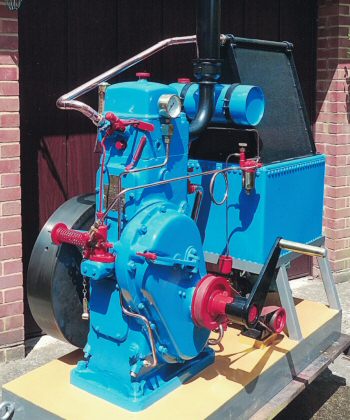 Surviving RQ engines in preservation:
Surviving RQ engines in preservation:
At least eight RQs have survived and are now in preservation.
No 734 This single-cylinder RQ, No 734 of 1936, was acquired by the late Cliff Noble of Surrey in December 2010. It was originally supplied to Seaborn Brothers of East Bergholt, near Colchester. Following restoration by Cliff the engine "fired up on second cranking" on 17th May 2015 and ran very well.
Right: Cliff Noble's restored 1RQ in May 2015. © Cliff Noble 2015
Subsequently the engine developed oil leaks and severe loss of oil pressure. Cliff sent an update in early November 2016. The engine's previous owner had told him, "you have no need to do anything to the bottom end as it has already been inspected". That cannot have been the case. Cliff dismantled the engine side plates and found the oil seals were of original leather construction. The seals were very hard and he was not surprised they leaked. Fortunately he was able to obtain some imperial seals through one of his contacts and these fitted perfectly. He dismantled the oil pump to find that the two faces against which the gears ran were badly corroded. He thinks this was due to water, possibly condensation, in the oil which had rusted it away. The flat plate of the oil pump was not a problem but to get the recess faces machined without damaging the gear diameters was a problem and he finished up having it done with a CNC machine which could be programmed to avoid damage. He also made a breather box and filled it with wire wool with a reed valve on top, to look like that on the single-cylinder RQ at Langford. The engine was reassembled and run up on 5th November 2016. Success! 50 psi oil pressure was achieved with no problem, there were no leaks from the crankshaft seals, and no blow-by from the breather box.
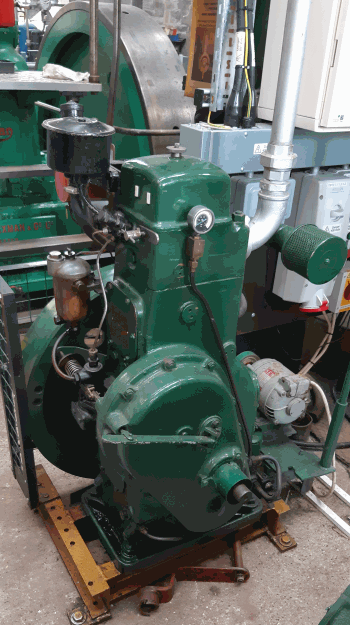 No 939 A single-cylinder RQ, believed to have been built in 1938, now in preservation at the Museum of Power, Langford, near Maldon, Essex. It was bequeathed to the museum by the late Alex Walford of Colchester. Originally supplied to a Mr Wilson of Clacton-on-Sea to generate power for a welding set in his workshop, it was in a poor and partially dismantled state when acquired by Mr Walford, only the second owner. He undertook a major rebuild of the RQ, rated 10 bhp at 1,000 rpm, to restore it to excellent running order.
No 939 A single-cylinder RQ, believed to have been built in 1938, now in preservation at the Museum of Power, Langford, near Maldon, Essex. It was bequeathed to the museum by the late Alex Walford of Colchester. Originally supplied to a Mr Wilson of Clacton-on-Sea to generate power for a welding set in his workshop, it was in a poor and partially dismantled state when acquired by Mr Walford, only the second owner. He undertook a major rebuild of the RQ, rated 10 bhp at 1,000 rpm, to restore it to excellent running order.
Right: Single-cylinder RQ, No 939, at the Museum of Power, March 2025.
Photo © Dick Waylen 2025
As originally designed, the engine was started by hand-cranking and release of a decompression lever. For safety reasons the museum has devised an alternative to hand-cranking. Visible in the bottom right corner of the photograph here is an electric motor (grey). This drives a jockey wheel that can be pushed by a lever to engage, by friction, with the engine's flywheel.
The engine is installed in the museum's old boiler room, and is usually run only on event days, details of which are posted on the museum's website.
(Visible at the top of the photograph on the right is the flywheel of the restored Paxman single-cylinder VK Heavy-Fuel-Oil Engine, No 23008, in the museum's collection.)
No 1120 A 6-cylinder RQ generator set ordered in 1938 by the GPO at the cost of £654 inclusive of starter motor, alternator, radiator, and its substantial cast iron bedplate.
It is an AMF (Automatic Mains Failure) set, provided with electrical controls and switchgear so that in the event of a mains power failure the engine could start up automatically, run up to speed, and take over the supply of electrical power. It would then be able to run unattended for a considerable period of time until the mains failure and its cause were identified and mains power restored. This was a very advanced arrangement at the time the set was built.
The set remained in service at British Telecom's Battery Green (Lowestoft) telephone repeater station until being retired in the 1980s. Following removal from Battery Green it was restored by apprentices at Paxman's works. The set was then installed in Paxman's Training School where, from time to time, it was started up for the benefit of visitors. Here the automatic starting and load carrying could still be demonstrated. If the engine was to be run for visitors, Vic Borley, a training instructor and former service engineer, would run the engine for a short time and then stop it before they arrived. A pre-warmed engine reduced the risk of an embarrassing starting problem in front of visitors! I remember the engine running very sweetly and remarkably quietly.
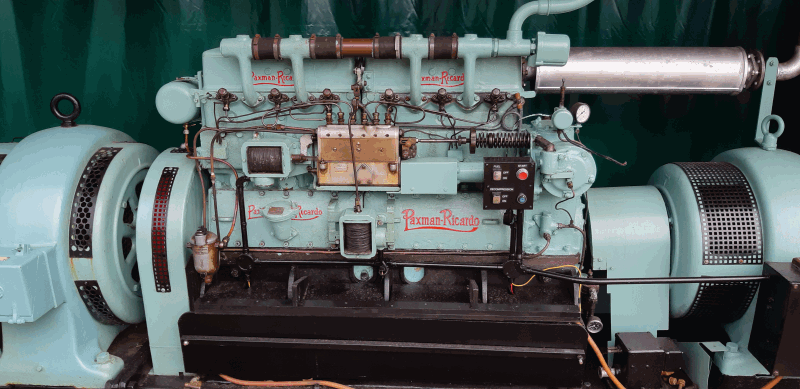
6RQ, No 1120, at the Museum of Power, Langford. Photo © Dick Waylen 2025.
The set is now in preservation at the Museum of Power, Langford, near Maldon, Essex. It is housed outside in a purpose-built weatherproof shelter which has covers that can be removed to display or run the set. It is usually run only on event days, details of which are posted on the museum's website.
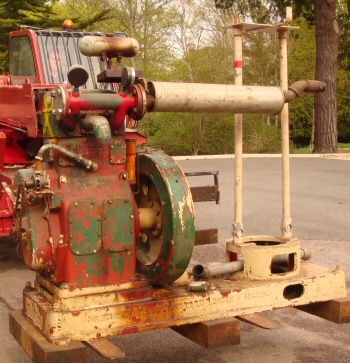 No 1139 This 2-cylinder RQ was formerly housed in a building of the Warsash Maritime Academy, near Southampton. When the building was being demolished in 2020, during the covid epidemic and following the closure of the academy's waterfront campus at Warsash, the engine was rescued by a college staff member using a telehandler. The engine and the base on which it was mounted were moved into the academy's boathouse where they remained in a corner for two or three years. Subsequently they were advertised on an auction website and sold in March 2024. The successful bidder and current owner (as at September 2024), Jeff Bower of Windsor, an engine collector, collected the engine from the boathouse the following month, on 11th April.
No 1139 This 2-cylinder RQ was formerly housed in a building of the Warsash Maritime Academy, near Southampton. When the building was being demolished in 2020, during the covid epidemic and following the closure of the academy's waterfront campus at Warsash, the engine was rescued by a college staff member using a telehandler. The engine and the base on which it was mounted were moved into the academy's boathouse where they remained in a corner for two or three years. Subsequently they were advertised on an auction website and sold in March 2024. The successful bidder and current owner (as at September 2024), Jeff Bower of Windsor, an engine collector, collected the engine from the boathouse the following month, on 11th April.
No 1139 was one of a pair of 2RQs (Nos. 1139 and 1140) supplied by Paxman to the Pulsometer Engineering Company Ltd of London & Reading. These engines are believed to have been built into pump sets by Pulsometer - probably fire pumps. Judging by their numbers, it is thought the engines were built in early 1940.
Right: Jeff Bower's 2RQ in April 2024. © Jeff Bower 2024
The maker's plate shows No 1139's power output to be 22/24.2 bhp at 1,000 rpm. This indicates the engine had a continuous rating of 22 bhp and a 10% overload rating of 24.2 bhp. Engines should only be run at their overload ratings for short periods.
The Pulsometer base on which the engine is mounted would indicate it was part of a pump set with a vertically mounted pump mounted via the horizontal flange at the other end. There would have been a right angle drive of some sort driving the pump which would either have been hanging under the Pulsometer base (and into the source of the water) or be somewhere below it driven by a vertical shaft.
It is not known whether the pump set was originally bought for Warsash primarily for firefighting duties or for instruction purposes, to give students experience of engine maintenance. Jeff says the engine looks as if it has done very few running hours. The oil and internals were clean. He is unsure if the engine had been stripped and rebuilt several times.
No 1619 A 2-cylinder RQ pumping set acquired by Andy Matthews of Coventry in spring 2020. In an email of March 2020 Andy reported that the hydraulic start worked well and that the engine ran very well. The set with its 2RQ, No 1619, is now owned by Chris Hawks and his son Jack who purchased it from Andy in 2024.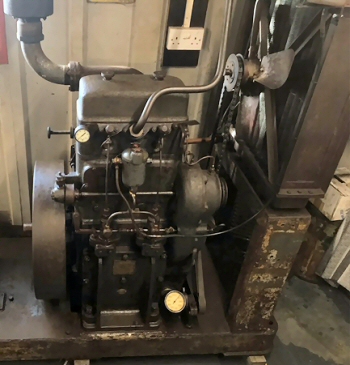
A surviving Paxman order book reveals that No 1619 was one of a batch of five 2RQ engines ordered by Hathorn Davey & Co Ltd, Sun Foundry, Leeds, Order Nos 1617 to 1621 inclusive. The Order Book entry shows the Destination as Great Western Railway. It is fair to conclude that the GWR ordered a batch of five pumping sets from Hathorn Davey who then ordered from Paxman the five 2RQ engines to drive the sets. No order date is entered in the book for these orders, but that for Order Nos 1615 and 1616 is 28-3-40, and that for Order No 1622 is 5-4-40 which suggests Hathorn Davey placed the orders for the 2RQs either in late March or early April 1940. In the order book the power output of each 2RQ is shown as 22 BHP at 1,200 rpm. This differs from the 19.5 BHP at 1,200 rpm rating shown on the engine’s plate.
Right: 2RQ No 1619 in 2024. © Chris Hawks 2024
Knowing the engine was originally destined for the GWR, Chris Hawks made enquiries of the National Railway Museum and previous contacts about the set's history. He learned that the GWR ordered the pumps from Hathorn Davey for pumping water from underground reservoirs to overhead water towers for steam locomotives. Like most GWR practices this was quite uneconomical and the plan was abandoned. The sets were sold off and No 1619 was sold to Port Talbot docks where it was used to pump excess water out of the dry docks. A plate on the bedplate of No 1619 includes the letters 'S.W.Docks'.
Subsequently the set was acquired by a farmer in Dover who used it as a drainage pump. It was then purchased by a collector who, for reasons unknown, removed the pump and coupling, before the set was acquired by Andy Matthews. Chris commented, in December 2024, that the engine is all original. Since coming into his ownership, the hydraulic starter has been removed and a link belt for driving the fan has been fitted to replace the missing original. The engine has been given a full service. It starts first time every time, and runs as sweet as a nut with a clear exhaust.
No 1927 A 4-cylinder RQ skid-mounted generator set, one of a batch of 300 sets ordered by the Ministry of Supply for the WW2 war effort. Built in 1941, the engine was rated 40 bhp at 1,000 rpm. It is coupled to a 30 kVA BTH (British Thomson-Houston) 6-pole, 3-phase, alternator generating 230 volts, 75.4 amps. The MoS ordered more than 1,100 of such sets during WW2 but No 1927 appears to be a rare surviving example. The set is now in preservation at Traktor Story & Galerija Konobon at Porec, in the Istria region of Croatia.
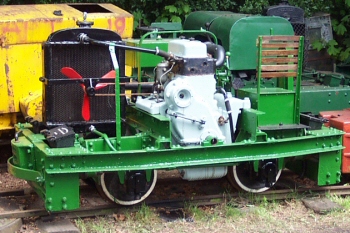 No 2047? A 2-cylinder RQ installed in a Hibberd 2ft gauge locomotive, No 2306. New to the War Office in 1940, the locomotive was originally powered by a National engine. By August 1953 the Hibberd was owned by The Hammill Brick Co, under whose ownership the original National engine was replaced by the Paxman 2RQ.
No 2047? A 2-cylinder RQ installed in a Hibberd 2ft gauge locomotive, No 2306. New to the War Office in 1940, the locomotive was originally powered by a National engine. By August 1953 the Hibberd was owned by The Hammill Brick Co, under whose ownership the original National engine was replaced by the Paxman 2RQ.
The locomotive was acquired in an exceptionally bad state, literally a wreck, by Simon Lomax who still owns it (as at 2024). In November 2000 it arrived at the Cadeby Light Railway which had been established by The Revd Teddy Boston at Cadeby Rectory in Leicestershire. Simon carried out a quite remarkable restoration of the locomotive and its engine, as can be seen in the picture here. After closure of the Cadeby Light Railway in 2005, the locomotive was moved in 2006 to the Apedale Valley Light Railway (AVLR), Newcastle-under-Lyme.
Right: The 2RQ in the Hibberd narrow gauge locomotive at Cadeby in May 2003.
Unfortunately the maker's plate is missing from the 2RQ so there is some uncertainty about its number. Simon says it seems likely Hibberd No 2306 swapped engines with another Hibberd, No 2586 of 1941. (By chance, No 2586 is now also at the AVLR.) The Hibberd lists show that No 2586 was fitted with 2RQ No 2047 so this seems most likely to be the engine now in No 2306. (Simon has a hand-written card with details of engines Nos. 2042, 2044 and 2048 but not 2047; he therefore thinks the 2RQ in Hibberd No 2306 is most probably Paxman No 2047.)
From surviving Paxman records it is known that a batch of seven 2RQ engines, Serial Numbers 2042 to 2048, was sold to F C Hibberd & Co, circa 1941. It has not been possible to ascertain from available surviving Paxman records where this Hibberd locomotive first ran with its 2RQ engine but it was possibly in some sort of munitions facility.
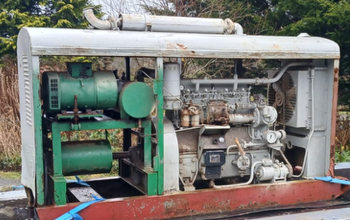 900038/37 A 4-cylinder RQ generator set bought by Andy Matthews of Coventry in December 2024, from an engine collector in Wales.
900038/37 A 4-cylinder RQ generator set bought by Andy Matthews of Coventry in December 2024, from an engine collector in Wales.
The previous owner told Andy the set came from Lincolnshire but he couldn’t remember where. One of Andy's friends said he had one of these sets many years ago and that it was a searchlight generator set. Close study of pictures of the set make its former purpose open to question, as explained below.
A small plate on the engine shows its rating as 42 bhp at 1100 rpm. As the design speed was 1100 rpm the engine would probably have driven a DC generator originally. An alternator (AC) set (for 50 Hz current) needs to run at either 1000 or 1500 rpm.
Stamped on the small plate is the number to be quoted when ordering parts: 900038/37. This is a Paxman 'sanction' number, used as the engine's serial number. Paxman built engines in batches and ordered in one go all the material required for building a batch of identical engines. The ordering of material for a batch had to be 'sanctioned' at Board level, hence the 'sanction number' term. The '9' of the number 900038/37 indicates a batch sanctioned in 1949. The number before the '/', in this case '38', is the number of the batch of material ordered that year. The number after the '/', in this case '37', is the number of the engine in that batch. Andy's set was probably built a year or two after 1949, the year in which ordering of the material for this batch was sanctioned. Unfortunately the RQ records that would match this sanction number to a contract number, and thus to a customer, no longer exist.
The set is now fitted with a Stamford alternator from the 1970s. Andy suggests the set's pulley arrangement and ratio would allow the engine to run at 1100 rpm while driving the alternator at 1500 rpm. He adds that the drive pulley is interesting and perhaps could have been used with a flat belt to drive other machinery.
Photographs of the set show it sitting on a skid type under-base. It looks as if the left hand end of the skid was originally longer and a section has been cut off. This suggests the main item of driven machinery sat on this removed section of under-base. There is no clue as to what it might have been. The Stamford alternator sitting under the canopy is not in line with the engine but sitting above the engine's output drive shaft and would appear to be belt driven. It would appear that in its present form, the set was not primarily a generating set; the provision of electrical power was probably only a secondary function. The set's former purpose remains unknown.
Acknowledgement: I am indebted to Don Meiklejohn, a fellow trustees of the Paxman Archive Trust, for researching and providing details of the numbers of RQ engines built. Also for his observations on the 4RQ 900038/37 set.
Richard Carr
Page updated: 13 Mar 2025 at 17:51
